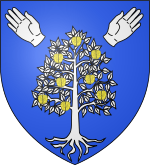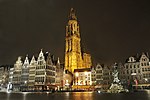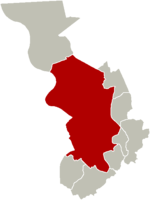Antwerp ( (listen); Dutch: Antwerpen [ˈɑntʋɛrpə(n)] (listen); French: Anvers [ɑ̃vɛʁs] (listen); Spanish: Amberes) is the largest city in Belgium by area at 204.51 km2 (78.96 sq mi) and the capital of Antwerp Province in the Flemish Region. With a population of 530,504, it is the most populous municipality in Belgium, and with a metropolitan population of around 1,200,000 people, it is the second-largest metropolitan region in Belgium, second only to Brussels.Antwerp is on the river Scheldt, linked to the North Sea by the river's Westerschelde estuary. It is about 40 km (25 mi) north of Brussels, and about 15 km (9 mi) south of the Dutch border. The Port of Antwerp is one of the biggest in the world, ranking second in Europe and within the top 20 globally. The city is also known as the hub of the world's diamond trade. In 2020, the Globalization and World Cities Research Network rated Antwerp as a Gamma + (third level/top tier) Global City.Both economically and culturally, Antwerp is and has long been an important city in the Low Countries, especially before and during the Spanish Fury (1576) and throughout and after the subsequent Dutch Revolt. The Bourse of Antwerp, originally built in 1531 and re-built in 1872, was the world's first purpose-built commodity exchange. It was founded before stocks and shares existed, so was not strictly a stock exchange. In 1920, the city hosted the Summer Olympics.
The inhabitants of Antwerp are nicknamed Sinjoren (Dutch pronunciation: [sɪˈɲoːrə(n)]), after the Spanish honorific señor or French seigneur, "lord", referring to the Spanish noblemen who ruled the city in the 17th century. The city's population is very diverse, including about 180 nationalities; as of 2019, more than 50% of its population had a parent that was not a Belgian citizen at birth. A particularly notable community among these is the close-knit Jewish one, as Antwerp is one of the only two cities in Europe (together with London and its Stamford Hill neighbourhood) that kept a considerable Haredi population in the 21st century; They are also more much visible than in London, due to them being concentrated around the centre.
The centre is also most notably home to the Antwerpen-Centraal railway station; eclectically built in a combination of Neo-Renaissance and Art Nouveau, it is considered to be one of the most beautiful train stations in the world.












